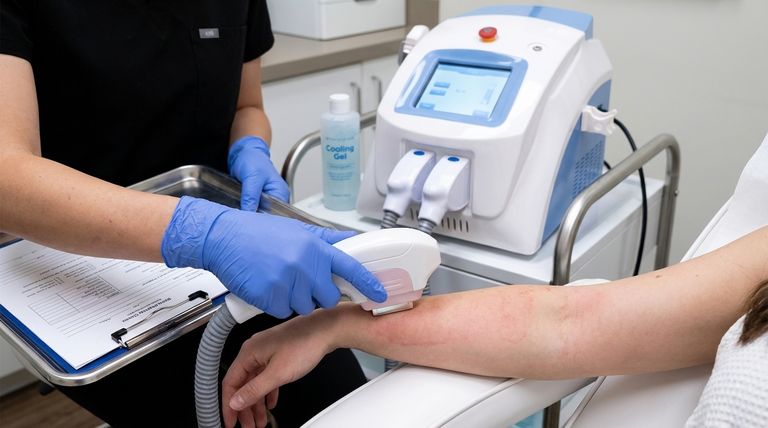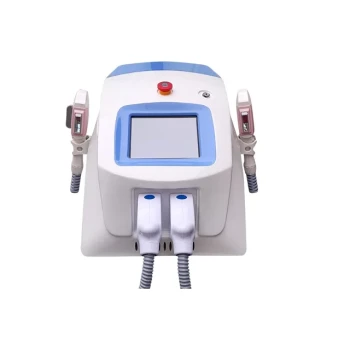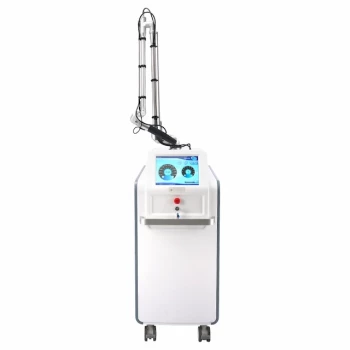Yes, all Intense Pulsed Light (IPL) treatments carry potential risks. While most common side effects are mild and temporary, such as redness and swelling, more serious adverse outcomes can occur. Incorrectly performed treatments can lead to significant injuries, including burns, blisters, and even permanent scarring.
The critical takeaway is that IPL risks are overwhelmingly tied to practitioner error and improper patient selection, not an inherent danger in the technology itself. Mitigating these risks depends almost entirely on choosing a qualified, experienced provider who can accurately assess your skin and use the equipment correctly.

Understanding the Spectrum of IPL Risks
IPL works by delivering a broad spectrum of light into the skin, where it is absorbed by a target—either melanin (pigment) or hemoglobin (in blood vessels). When this energy is delivered improperly, it can damage surrounding tissue.
Common and Expected Side Effects
These are generally mild, temporary, and a sign that the skin is responding to the treatment. They typically resolve within a few hours to a few days.
- Redness and Swelling: The most common reaction is a mild, sunburn-like sensation with associated redness (erythema) and some minor swelling in the treated area.
- Minor Discomfort: Patients often describe the sensation during treatment as a "rubber band snap" against the skin.
- Pigment Darkening: Brown spots and freckles will often temporarily darken immediately after treatment before flaking off over the next one to two weeks. This is an expected part of the process.
Less Common but More Serious Risks
These adverse events are almost always the result of incorrect settings for a patient's skin type, a lack of operator experience, or failure to follow pre- and post-care instructions.
- Burns and Blisters: This occurs when the energy level is too high for the skin to safely absorb. It is a significant risk for those with darker skin tones or a recent tan.
- Hyperpigmentation: The skin can become overstimulated and produce excess melanin, resulting in dark patches. This is known as post-inflammatory hyperpigmentation (PIH) and is more common in individuals with darker skin.
- Hypopigmentation: A less common risk is the destruction of melanin-producing cells, which can cause permanent white spots or a lightening of the natural skin tone.
- Permanent Scarring: While rare, scarring can occur as a direct result of a poorly managed burn, blister, or infection following the procedure.
Key Factors That Determine Your Risk Profile
Your personal risk is not static; it is influenced by a clear set of variables. Understanding these factors empowers you to make a safer choice.
The Practitioner's Skill
This is the single most important factor. An experienced technician or clinician knows how to analyze skin, select the correct device settings, and recognize early signs of an adverse reaction. An untrained operator is the primary cause of serious injury.
Your Skin Type and Color
IPL is most effective and safest for individuals with lighter skin tones (Fitzpatrick types I-III). The risk of burns and pigmentary changes increases significantly for darker skin types because the light is absorbed by the melanin in the skin itself, not just the target pigment or vessel.
Recent Sun Exposure
Treating tanned skin is extremely dangerous. A tan indicates that the melanin-producing cells (melanocytes) are active and sensitive. Applying IPL to tanned skin dramatically increases the risk of burns and hyperpigmentation.
How to Minimize Risks and Ensure a Safe Treatment
Your role in ensuring a safe outcome is proactive. You can significantly reduce your risk by prioritizing safety and diligence in your selection process.
- If your primary focus is safety: Seek treatment from a board-certified dermatologist's office or a highly reputable medical spa supervised by a physician.
- If your primary focus is getting effective results: Insist on a thorough consultation and a spot test to confirm how your skin will react before committing to a full treatment session.
- If you are preparing for your appointment: Strictly avoid all sun exposure, tanning beds, and sunless tanners for at least four weeks before and after your session to prevent complications.
By understanding these variables and choosing your provider with care, you can confidently and safely leverage the benefits of IPL technology.
Summary Table:
| Risk Level | Common Side Effects | Serious Risks | Primary Cause |
|---|---|---|---|
| Common & Mild | Redness, swelling, minor discomfort, temporary darkening of spots | - | Normal skin response to treatment |
| Less Common & Serious | - | Burns, blisters, permanent scarring, hyper/hypopigmentation | Practitioner error, incorrect settings for skin type |
Prioritize Safety and Superior Results with BELIS
Choosing the right equipment is just as critical as choosing the right practitioner. BELIS specializes in providing professional, reliable, and advanced medical aesthetic equipment to clinics and premium beauty salons. Our IPL devices are engineered with safety features and precision controls to help qualified practitioners deliver effective treatments while minimizing risks.
Partner with BELIS to equip your practice with technology you and your clients can trust.
Contact our experts today to learn how our professional-grade equipment can enhance your service offerings and ensure superior patient outcomes.
Visual Guide

Related Products
- IPL SHR Hair Removal Machine for Permanent Hair Removal
- Clinic Use IPL and SHR Hair Removal Machine with Nd Yag Laser Tattoo Removal
- Multifunctional Laser Hair Growth Machine Device for Hair Growth
- IPL SHR+Radio frecuency machine
- Multifunctional Laser Hair Growth Machine Device for Hair Growth
People Also Ask
- What are the negative effects of IPL? Understanding Risks for Safe Treatment
- Can IPL be used on all skin types? Understanding Risks for Darker Skin Tones
- Does IPL hair removal really work? Unlock Long-Term Hair Reduction with Science
- What is intense pulsed light good for? A Versatile Solution for Sun Spots, Redness, and Hair
- Can you use hair removal device on private parts? A Guide to Safe Bikini Area IPL



















